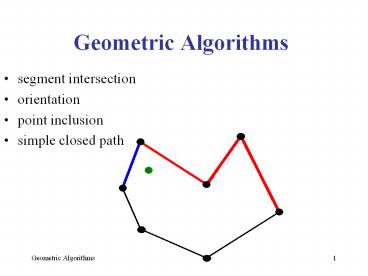segment intersection - PowerPoint PPT Presentation
Title:
segment intersection
Description:
counterclockwise (left turn) -clockwise (right turn) -collinear (no turn) Examples: ... right turn. collinear. no turn. a. b. c. Geometric Algorithms. 6 ... – PowerPoint PPT presentation
Number of Views:110
Avg rating:3.0/5.0
Title: segment intersection
1
Geometric Algorithms
- segment intersection
- orientation
- point inclusion
- simple closed path
2
Basic Geometric Objects in the Plane
point denoted by a pair of coordinates (x,y)
segment portion of a straight line between two
points
polygon circular sequence of points (vertices)
and segments (edges)
3
Some Geometric Problems
Segment intersection Given two segments, do they
intersect
Simple closed path given a set of points, find a
non-intersecting polygon with vertices on the
points.
Inclusion in polygon Is a point inside or outside
a polygon ?
4
An Apparently Simple Problem Segment Intersection
- Test whether segments (a,b) and (c,d) intersect.
How do we do it? - We could start by writing down the equations of
the lines through the segments, then test whether
the lines intersect, then ... - An alternative (and simpler) approach is based in
the notion of orientation of an ordered triplet
of points in the plane
a
d
c
b
5
Orientation in the Plane
- The orientation of an ordered triplet of points
in the plane can be - -counterclockwise (left turn)
- -clockwise (right turn)
- -collinear (no turn)
- Examples
b
c
a
a
c
b
(
)
counter
c
loc
kwise
left turn
(
)
c
loc
kwise
right turn
a
c
b
(
)
collinear
no turn
6
Intersection and Orientation
- Two segments (p1,q1) and (p2,q2) intersect if and
only if one of the following two conditions is
verified - general case (p1,q1,p2) and (p1,q1,q2) have
different orientations and (p2,q2,p1) and
(p2,q2,q1) have different orientations - special case (p1,q1,p2), (p1,,q1,q2),
(p2,q2,p1), and (p2,q2,q1) are all collinear and
the x-projections of (p1,q1) and (p2,q2)
intersect the y-projections of (p1,q1) and
(p2,q2) intersect
p
1
q
2
q
p
1
2
7
Examples (General Case)
- general case (p1,q1,p2), and (p1,q1,q2) have
different orientations and (p2,q2,p1) and
(p2,q2,q1) have different orientations
(p1,q1,p2), (p1,q1,q2), (p2,q2,p1), (p2,q2,q1)
(p1,q1,p2), (p1,q1,q2), (p2,q2,p1), (p2,q2,q1)
8
Examples (General Case)
- general case (p1,q1,p2), and (p1,q1,q2) have
different orientations and (p2,q2,p1) and
(p2,q2,q1) have different orientations
(p1,q1,p2), (p1,q1,q2), (p2,q2,p1), (p2,q2,q1)
(p1,q1,p2), (p1,q1,q2), (p2,q2,p1), (p2,q2,q1)
9
Examples (Special Case)
- general case (p1,q1,p2), and (p1,q1,q2) have
different orientations and (p2,q2,p1) and
(p2,q2,q1) have different orientations
(p1,q1,p2), (p1,q1,q2), (p2,q2,p1), (p2,q2,q1)
(p1,q1,p2), (p1,q1,q2), (p2,q2,p1), (p2,q2,q1)
10
How to Compute the Orientation
- slope of segment (p1,p2) ? (y2-y1) / (x2-x1)
- slope of segment (p2,p3) ? (y3-y2) / (x3-x2)
- Orientation test
- counterclockwise (left turn) ? lt ?
- clockwise (right turn) ? gt ?
- collinear (left turn) ? ?
- The orientation depends on whether the expression
- (y2-y1) (x3-x2)- (y3-y2) (x2-x1)
- is positive, negative, or zero.
p
3
p
2
x
-
x
3
2
p
x
-
x
1
2
1
11
Point Inclusion
- given a polygon and a point, is the point inside
or outside the polygon? - orientation helps solving this problem in linear
time
12
Point Inclusion Part II
- Draw a horizontal line to the right of each point
and extend it to infinity - Count the number of times a line intersects the
polygon. We have - -even number ? point is outside
- -odd number ? point is inside
- Why?
a
b
c
d
e
f
g
What about points d and g ?? Degeneracy!
13
Degeneracy
- Degeneracies are input configurations that
involve tricky special cases. - When implementing an algorithm, degeneracies
should be taken care of separately -- the general
algorithm might fail to work. - For example, in the previous example where we had
to determine whether two segments intersect, we
have degeneracy if two segments are collinear.
The general algorithm of checking for orientation
would fail to distinguish whether the two
segments intersect. Hence, this case should be
dealt with separately.
14
Simple Closed Path Part I
ProblemGiven a set of points ...
Connect the dots without crossings
15
Simple Closed Path Part II
Pick the bottommost point a as the anchor point
For each point p, compute the angle q(p) of the
segment (a,p) with respect to the x-axis
a
16
Simple Closed Path Part III
- Traversing the points by increasing angle yields
a simple closed path - -The question is how do we compute angles?
- -We could use trigonometry (e.g., arctan).
- -However, the computation would be inefficient
since trigonometric functions are not in the
normal instruction set of a computer and need a
call to a math-library routine. - -Observation, we dont care about the actual
values of the angles. We just want to sort by
angle. - Idea use orientation to compare angles without
actually computing them!!
a
17
Simple Closed Path Part IV
- Orientation can be used to compare angles without
actually computing them ... Cool! - q(p) lt q(q) ? orientation of (a,p,q) is
counterclockwise - We can sort the points by angle by using any
sorting-by-comparison algorithm (e.g., heapsort
or merge-sort) and replacing angle comparisons
with orientation tests - We obtain an O(N log N)-time algorithm for the
simple closed path problem on N points
p
q
a































